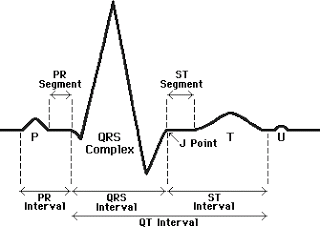Another busy month in overdose-related research (11 papers), including several toxicology and epidemiology papers, some of which represent novel analytic approaches that serve to advance the field.
Berling I, Whyte IM, Isbister GK.
QJM. 2012 Sep 28. [Epub ahead of print]
PMID: 23023890 [PubMed – as supplied by publisher]
Comment: High-dose opioids can cause QT prolongation, a hypothetical bugaboo for methadone maintenance. What is QT prolongation? It is a warning sign that somebody might be at risk for a potentially fatal heart rhythm. More detail, you ask? Well, the EKG is a record of electrical activity in the heart – see below. Some medications make the time from Q to T longer. If it gets long enough (usually requiring very high doses of opioids in combination with either other medications or a genetic tendency to have a long QT) it can result in a dangerous heart rhythm.

Huang CL, Chung-Wei L.
J Subst Abuse Treat. 2012 Sep 25. pii: S0740-5472(12)00138-9. doi: 10.1016/j.jsat.2012.08.003. [Epub ahead of print]
Comment: Methadone is protective from death, but there still is quite a bit of mortality, including overdose.
Okuda S, Ueno M, Hayakawa M, Araki M, Kanda F, Takano S.
Rinsho Shinkeigaku. 2012;52(9):672-6.
Comment: Two case reports of a debilitating white matter brain disease from benzodiazepine overdose.
- The relationship between alcohol use and injecting drug use: Impacts on health, crime and wellbeing.
Dietze P, Jenkinson R, Aitken C, Stoové M, Jolley D, Hickman M, Kerr T.
Drug Alcohol Depend. 2012 Sep 15. pii: S0376-8716(12)00330-4. doi: 10.1016/j.drugalcdep.2012.08.013. [Epub ahead of print]
Comment: Drug injectors who drink heavily have more violent crime and poorer life satisfaction. Somewhat surprisingly, other health outcomes (like heroin overdose) did not survive controlling for potential confounders.
Bekjarovski N, Chaparoska D, Radulovikj-Bekjarovska S.
Prilozi. 2012 Jul;33(1):313-8.
Comment: Tramadol is an interesting drug, with some opioid-esque effects, but not really an opioid. Seizures can result from tramadol overuse.
Walley AY, Doe-Simkins M, Quinn E, Pierce C, Xuan Z, Ozonoff A.
J Subst Abuse Treat. 2012 Sep 11. pii: S0740-5472(12)00121-3. doi: 10.1016/j.jsat.2012.07.004. [Epub ahead of print]
Comment: A descriptive piece on the application of the Massachusetts overdose education and naloxone distribution project to methadone maintenance programs. Massachusetts has been a leader in broad-based naloxone distribution and innovative efforts to evaluate the intervention.
McDermott C, Collins NC.
Emerg Med Int. 2012;2012:476161. Epub 2012 Aug 16.
Comment: Naloxone administration by the intranasal route has been increasingly adopted by emergency medical service programs, at least around the United States. However, this route of administration has never been approved by the Food and Drug Administration (this is not unusual or illegal – medical providers frequently use medications “off-label” for indications or by routes that have not gone through the expensive process of FDA approval). This is a nice evaluation of how quickly a drug can be administered by intranasal (87 seconds) compared to IV (178 seconds) and the perceived safety of those two routes of administration. Advanced paramedic trainees preferred the intranasal route.
Kurogi K, Chen M, Lee Y, Shi B, Yang T, Liu MY, Sakakibara Y, Suiko M, Liu MC.
Drug Metab Lett. 2012 Aug 31. [Epub ahead of print] Comment: Details on metabolism of naloxone, buprenorphine, and pentazocine.
Centers for Disease Control and Prevention (CDC).
MMWR Morb Mortal Wkly Rep. 2012 Jul 6;61(26):493-7.
Comment: Methadone was responsible for about a third of opioid analgesic deaths in 2010. It is important to note that these deaths are mostly from pain prescriptions rather than maintenance programs. In addition, it is important to consider that the causal agents in opioid analgesic deaths vary by state, along with prescribing patterns. For example, this analysis of 13 states did not include Florida, which had an enormous problem with oxycodone/OxyContin prescribing. In fact, a major driver in the transition to methadone for many state insurance programs was the growing OxyContin overdose death epidemic. Nonetheless, there are complexities to titrating methadone that are poorly understood by many providers and most patients
Paulozzi LJ, Kilbourne EM, Shah NG, Nolte KB, Desai HA, Landen MG, Harvey W, Loring LD.
Pain Med. 2012 Jan;13(1):87-95. doi: 10.1111/j.1526-4637.2011.01260.x. Epub 2011 Oct 25.
Comment: Very challenging and intriguing case-control study (300 cases) of prescription overdose death from the CDC injury center. This is a boost in our understanding of the risk factors for overdose death, which include dose of opioids (a surprisingly steep increase in risk with relatively low doses of opioids [as low as 20 morphine equivalents daily]) and number of prescriptions (overlapping prescriptions for opioids appeared to be a major issue). The finding that selected opioids were associated with death is intriguing and worthy of further exploration. The strong association with buprenorphine prescription (although with a very wide confidence interval) is discussed by the authors with a reasonable conclusion that this may be related to resumption of heroin use rather than overdose on buprenorphine itself. The fact that the association with methadone is similar to that with fentanyl and hydromorphone (Dilaudid) suggests that overdose risk may reflect as much the population receiving the prescription as the pharmacology of a given agent.
Bohnert AS, Roeder KM, Ilgen MA.
Drug Alcohol Depend. 2011 Dec 1;119(1-2):106-12. Epub 2011 Jun 28.
Comment: This is an intriguing analysis of the complex issue of suicide and drug overdose based on a large cross-sectional dataset of substance use treatment patients (N=5892). Twenty percent were in treatment for marijuana, 42% for alcohol, 61% for cocaine, and 19% for heroin. I would be interested in seeing the analysis restricted to those in treatment for heroin, as that is a more homogenous group at higher risk for overdose. Also, while we know that only a small proportion of heroin overdose among heroin users is intentional, an analysis such as this may help to tease apart how much overdose is related to attempts at self-harm.